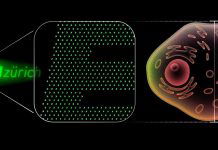
Digital cameras have long worked in the same way: they capture light in three color channels—red, green, and blue—just as the human eye does.
That’s enough to produce the full range of colors we see, but it only samples three points from the much broader spectrum of visible light.
Specialized cameras called hyperspectral imagers can do more, breaking light into dozens or even hundreds of wavelength slices.
This lets scientists detect subtle differences invisible to the naked eye, but until now, hyperspectral imaging has been slow, bulky, and expensive—limited mostly to still images or very low-frame-rate video.
Researchers at the University of Utah’s John and Marcia Price College of Engineering have now developed a compact new camera that overcomes those limits.
The device can record high-definition hyperspectral video, capturing 25 distinct slices of the spectrum in a single shot, fast enough for real-world use. Remarkably, the camera is small enough to fit into something like a smartphone.
The innovation comes from a diffractive optical element, a nanoscale patterned filter placed directly on top of the camera sensor.
Instead of simply dividing light into red, green, and blue, the filter splits it into 25 channels.
Each pixel on the sensor records compressed information about both the image and its spectral details. Sophisticated computer algorithms can then reconstruct the data into a “cube” of 25 images, each representing a unique slice of the visible spectrum.
“Essentially, every pixel gets a spectral fingerprint,” said Professor Rajesh Menon, who co-led the project. “This allows us to see fine details that traditional cameras miss.”
The camera’s design was detailed in the journal Optica by Research Assistant Professor Apratim Majumder and Menon.
The system not only captures much more information than traditional cameras, it does so quickly and at a fraction of the cost of commercial hyperspectral systems.
By compressing the spectral data into a two-dimensional image, storage and transmission also become far easier—an advantage for satellites, which often struggle to send down large volumes of data.
To prove its usefulness, the Utah team tested the camera in three scenarios: distinguishing between tissues in surgical scenes, tracking how strawberries aged and decayed, and mimicking the filters astronomers use to study starlight. In each case, the compact system produced high-quality spectral video, showing its potential across fields like medicine, agriculture, and astronomy.
The current prototype records at just over one megapixel resolution, but the researchers are already working on a higher-resolution version with more spectral channels. They are also refining the diffractive element to make it easier to produce at scale.
By shrinking the size, cost, and complexity of hyperspectral imaging, the Utah team has opened the door to applications once out of reach.
From diagnosing disease to monitoring crops or studying the cosmos, this breakthrough camera technology could change how we see the world—by revealing the hidden colors within it.
Source: University of Utah.



